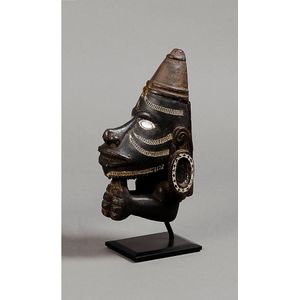Solomon Islands Canoe Prow Figurehead
You must be a subscriber, and be logged in to view price and dealer details.
Subscribe Now to view actual auction price for this item
When you subscribe, you have the option of setting the currency in which to display prices to $Au, $US, $NZ or Stg.
- Mother-Of-Pearl - Mother-of-pearl, technical name "nacre", is the inner layer of a sea shell. The iridescent colours and strength of this material were widely used in the nineteenth century as an inlay in jewellery, furniture, (especially papier mache furniture) and musical instruments.
In the early 1900s it was used to make pearl buttons. Mother-of-pearl is a soft material that is easily cut or engraved.
Nowadays it is a by-product of the oyster, freshwater pearl mussel and abalone industries. - Circa - A Latin term meaning 'about', often used in the antique trade to give an approximate date for the piece, usually considered to be five years on either side of the circa year. Thus, circa 1900 means the piece was made about 1900, probably between 1895 and 1905. The expression is sometimes abbreviated to c.1900.
This item has been included into following indexes:
Visually similar items

An early 20th century waka huia (treasure box), the handle with mirrored tekoteko figures connected at the head above carved wheku heads with inset paua shell eyes. The bowl supported on two humanistic forms with tongues extended and full moko, carved with

A Sago jar, East Sepik, Papua New Guinea. Stoneware and natural earth pigments. Collected during World War I. 28.5 cm x 15 cm

Large decorative wooden Thai reclining Buddha figure, split and showing signs of wear. Length 1500

Bust of Buddha possibly Thai 13 cm high
